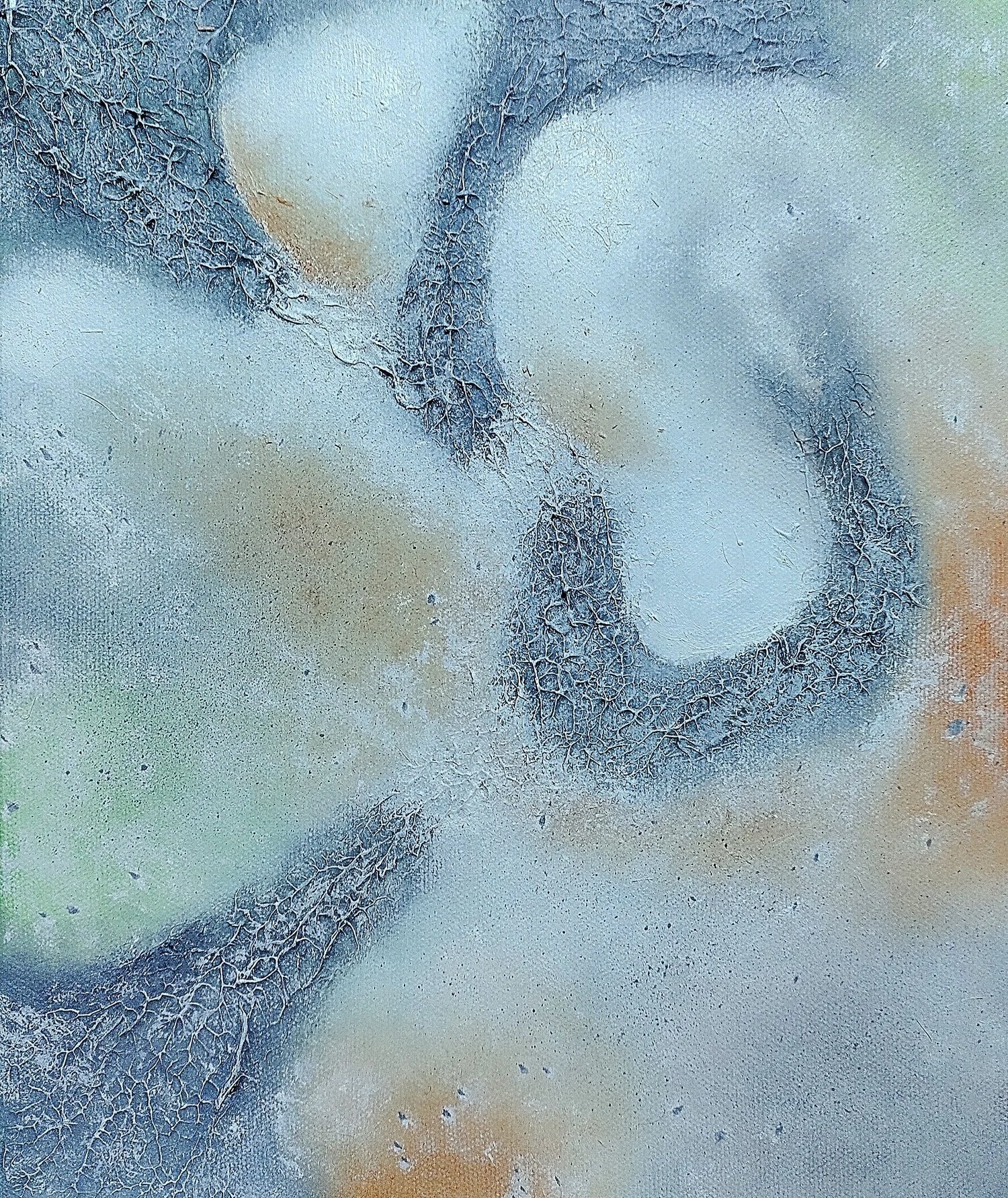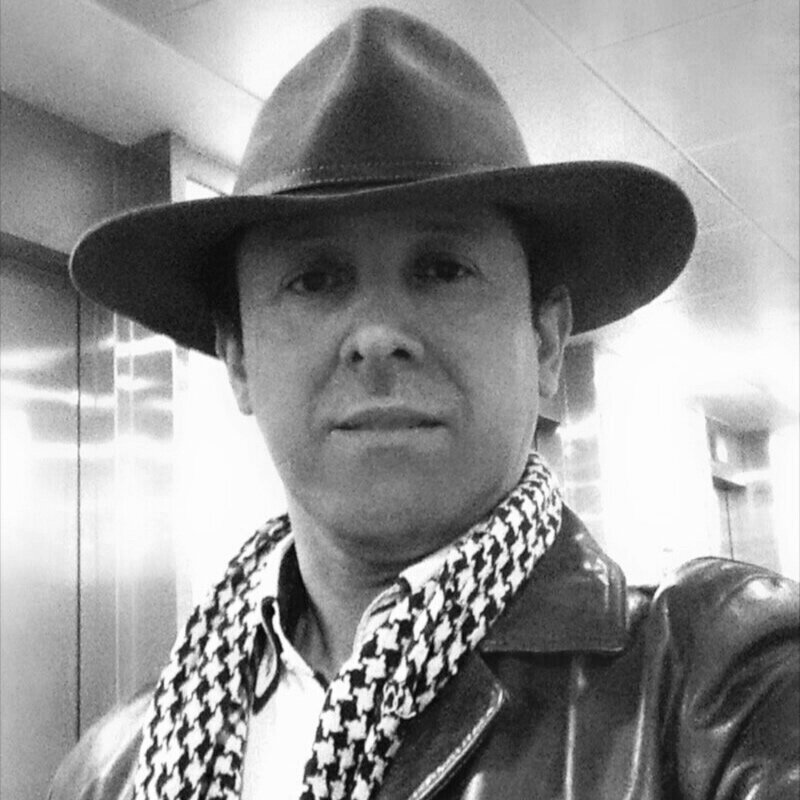10 Questions with German Bustamante
Santiago-based, self-taught abstract artist German Bustamante was born in Chile, but he was raised and educated in the UK. Abstraction has allowed him to express his own spiritual vision of life represented by symbolic imagery that deals with ethereal planes, astral projections, primeval feelings, mental and emotional journeys and other intangible human issues.
He is a Circle Foundation for the Arts Affiliate Artist and a member of Biafarin, a Canadian art business platform. Private collectors and realtors have purchased his work both in Hong Kong and in Chile. Articles and interviews about his work have appeared in the 18 and 20 issues of Spotlight Magazine (France), in the special edition of Observica Art Magazine (Canada) and in The Artists Corner Magazine (US).
In 2020 he was exhibited at the Expo Metro Opera-La Fayette in Paris, France, and at The Swiss Art Expo in Zurich, Switzerland. In 2021 his work was exhibited at the Artbox Project World 1.0 in the Artbox Gallery in Zurich, Switzerland and in the International Exhibition of Contemporary Art Aspettando l’evento, held by the Associazione Culturale “Sei l’Arte” in Italy and worldwide.
German Bustamante portrait
ARTIST STATEMENT
Each painting is a journey for German. A journey into his inner self. It’s an emotional and absorbing process that talks about his spiritual and metaphysical concepts of who we really are and why we chose to come and live in this dual-density plane.
Colours are very important in this journey for him as well. He usually works in many thin layers of paint on top of each other. Each new layer gives new inspiration for the following one. Sometimes he sketches out his compositions; sometimes they are just intuitive sensations. German uses gesso (soft or sandy), heavy gel, mineral or brick powder and sugar for textures. His tools usually vary from brushes (hard or soft), paper towels, rags, painting knives or his own fingers.
Tierra del Fuego, Oil on canvas, 24x28 inch, 2020 © German Bustamante
INTERVIEW
First of all, introduce yourself to our readers. Who are you and how did you start experimenting with images?
I was born in Santiago, Chile, but my family moved to Manchester, in the North West of England, where I was raised and educated. I was an avid reader when I was a teen, so I started painting fantasy landscapes in acrylic. My artistic inspiration was mainly based on the books I read at that time. Little by little, I turned into oil in figurative style, and I also pencil drew portraiture, mainly female. My first selling was an equine collection of 12 pieces I painted in oil. It was quite an exciting moment indeed. It feels really nice when people love what you do and want to have that part of you in their home. Then, in 2015 I started working more and more in abstract style. I'm still developing my own style, though. And I would like to refine it as much as possible. I know everything changes and evolves. It's already changing in a way, and I like it. I think that's the beauty of art—the never-ending challenge of re-defining yourself.
How would you define yourself as an artist?
I'm a self-taught abstract artist, so everything has been experimenting and learning. My work is like a metaphor that contains more than one meaning. I've been using symbolic imagery to deal with that, to show different kinds of landscapes. I feel I'm really alive when I'm painting. I enjoy the whole process even when I don't feel satisfied with the result because I know it can be improved and corrected.
Quietud, Oil and heavy gel on canvas, 28x24 inch, 2021 © German Bustamante
Can you tell us about the process of creating your work? What is your artistic routine when working?
I usually paint 4 or 5 hours a day, either in the morning or in the afternoon, depending on the day and the activities I have to do. That's my usual routine. However, at the weekend, I can get a bit obsessed and spend much longer working on a piece. Sometimes my process is just intuitive. I start with something, but it disappears completely by the end of the painting; sometimes, I just sketch out my compositions, and the idea is much clearer from the beginning. I've used soft gesso, structure gel, mineral powder, and gritty materials for texture in some of my paintings. Colours are very important as well. I use earth tones a lot. Cadmiums, alizarin, viridians, cobalt, ultramarine, and phthalic are all in my palette. My tools are usually brushes, paper towels, painting knives, and my own fingers and elbows.
Where do you find inspiration for your work?
Each painting is a journey for me, a journey into my inner self. It's an emotional and absorbing process that talks about my spiritual and metaphysical concepts of who we really are and why we chose to come and live in this dual-density plane. Abstraction has allowed me to express all this in a rather metaphorical way on the canvas. I feel free to explore.
What do you see as the strengths of your art, visually or conceptually?
Passion, creativity, composition, chromatic vibrations, textures, and all these structures from the subconscious. And determination.
Wind's Eyes, Oil on canvas, 32x47 inch, 2020 © German Bustamante
How do you differentiate yours from the rest? In other words, what do you feel makes your work unique and truly your own?
I'm just an artist who develops a story that has to be felt and explored. It's a very personal story, and every person feels and sees something different from my work. I just love that. I think every artist is unique; every piece of art is unique and touches others.
What's one essential element in your art?
I think intensity, emotion, authenticity, and the ability to create a personal universe that connects with people.
Do you find that the shift to digital exhibitions and art fairs has helped you promote your work?
Yes, absolutely. Digital exhibitions and art fairs have been wonderful opportunities for me, and I really appreciate every chance I have to promote my work. This pandemic situation has affected all of us in one way or another. Sales have dropped in the last year, more than half of art fairs were cancelled or put on pause, but fortunately, after a change of dates, the work of other artists and my own work have been exhibited. I think this health crisis has provided the impetus for changing into new digital offers and opportunities. I believe they will have a positive lasting impact because they lower the barriers to participate for artists.
Another World, Oil, soft gesso and acrylic on canvas, 24x32 inch, 2021 © German Bustamante
A Crack in Time, Oil, acrylic and heavy gel on canvas, 32x40 inch, 2020 © German Bustamante
What do you think about the art community and market?
I think despite this global tragedy, the art market and art community have rebounded via digital technology, and they have massively adopted within a record time. However, I don't think this will be the norm forever, but it's here to stay. I think exhibitions, art fairs, and galleries will be both in-person and virtually, and I also think collectivity and collaboration will be the way forward in the following years.
Finally, any projects you are looking forward to for this year?
Oh, yes. I'm looking forward to a collaboration project with an art gallery in Spain. I'll keep my fingers crossed. I feel very excited about that. I also hope I will be able to take part in another exhibition this year and, of course, continue working on new paintings, new journeys.













